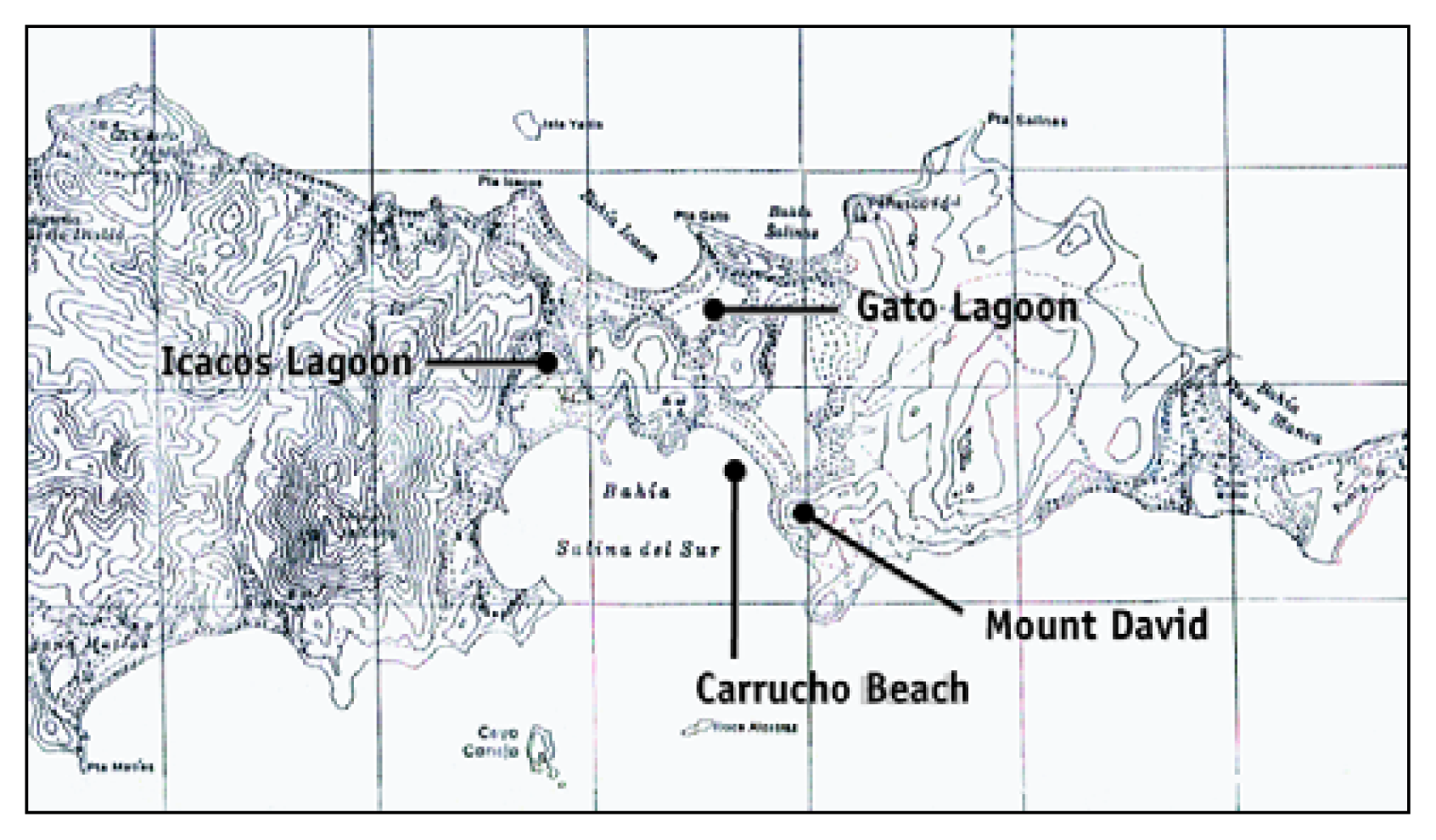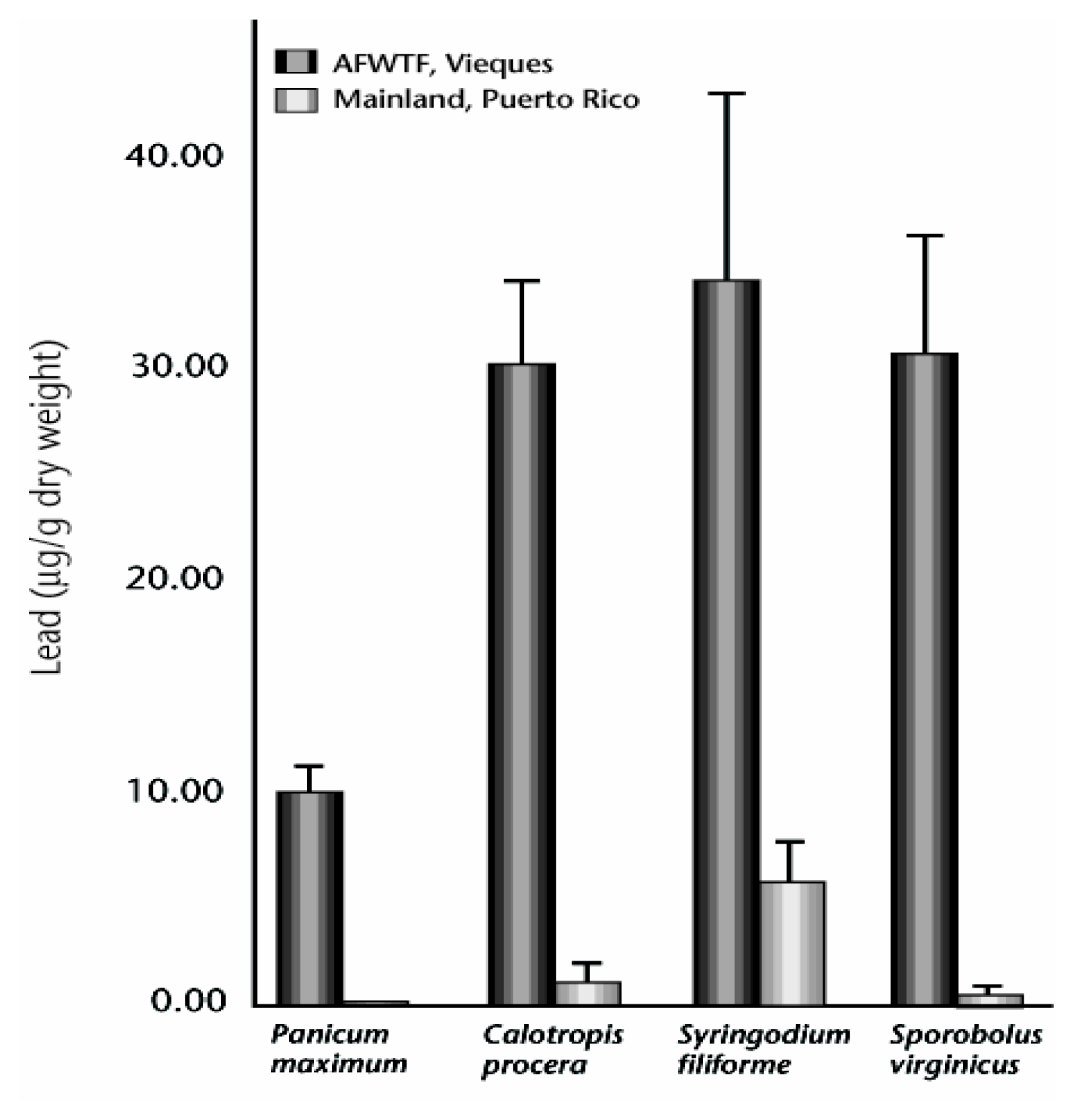Trace Elements Analysis in Forage Samples from a US Navy Bombing Range (Vieques, Puerto Rico)
Abstract
:Introduction
Materials and Methods
Study Sites
Sampling Protocol
Metal Analysis in Vegetation
Results and Discussion


| 1Chemical Element (μg/g dry weight) | |||||||
|---|---|---|---|---|---|---|---|
| Pb | Co | Ni | Mn | Cr | Cd | Cu | |
| Mount David | |||||||
| Panicum maximum (roots) | 12.85 | 63.66 | 14.19 | 115.4 | 21.04 | 2.89 | 17.10 |
| (2.10) | (0.86) | (4.72) | (47.1) | (8.56) | (0.43) | (8.11) | |
| P. maximum (leaves) | 10.25 | 46.65 | 5.08 | 135.0 | 5.99 | 1.57 | 4.03 |
| (1.27) | (8.91) | (3.25) | (31.7) | (0.58) | (0.14) | (3.34) | |
| Calotropis procera (leaves) | 30.05 | 68.40 | 18.08 | 287.9 | 12.68 | 3.11 | 4.63 |
| (3.63) | (9.08) | (2.50) | (3.4) | (2.82) | (2.09) | (4.25) | |
| Acacia farnesiana (stems) | 8.13 | 10.15 | 5.33 | 18.3 | 2.86 | nd | 4.04 |
| (1.74) | (1.08) | (1.29) | (0.1) | (0.92) | (1.31) | ||
| Icacos Lagoon | |||||||
| Aquatic plant (leaves) | 2.69 | 36.31 | 29.31 | 1,740.4 | 42.14 | 4.63 | 12.93 |
| (1.07) | (26.66) | (2.45) | (145.5) | (3.52) | (1.68) | (3.66) | |
| Gato Lagoon | |||||||
| Ipomoea violacea (fruits) | 32.61 | 25.75 | 7.64 | 40.3 | 1.17 | nd | 9.39 |
| (9.17) | (3.89) | (4.31) | (0.1) | (0.03) | (3.52) | ||
| Sporobolus virginicus (roots) | 17.17 | 68.61 | 78.26 | 882.4 | 182.62 | 1.18 | 10.36 |
| (1.81) | (5.59) | (12.81) | (99.8) | (9.59) | (0.07) | (11.44) | |
| S. virginicus (leaves) | 30.45 | 34.81 | nd | 670.6 | 5.32 | nd | nd |
| (5.36) | (1.80) | (267.9) | (0.99) | ||||
| S. pyramidatus (roots) | 18.77 | 22.91 | 7.14 | 156.2 | 15.77 | 2.25 | 9.02 |
| (5.27) | (2.61) | (2.67) | (1.8) | (2.09) | (1.07) | (2.14) | |
| S. pyramidatus (leaves) | 12.19 | 2.73 | 1.25 | 31.8 | 3.03 | nd | nd |
| (2.71) | (0.13) | (0.52) | (3.0) | (0.29) | |||
| 1Chemical Element (μg/g dry weight) | |||||||
|---|---|---|---|---|---|---|---|
| Pb | Co | Ni | Al | As | Cd | Cu | |
| AFWTF-2001 (Active) | 33.32 | 29.60 | 28.66 | na | na | 0.28 | 30.48 |
| (10.77) | (5.51) | (1.58) | na | na | (0.13) | (3.63) | |
| AFWTF-2004 (Non-active) | 8.14 | 10.61 | 3.43 | 154.3 | 0.61 | 0.15 | 17.42 |
| (3.15) | (4.21) | (2.13) | (67.7) | (0.46) | (0.15) | (1.83) | |
| Guánica-2001 | 5.58 | 4.19 | 14.64 | na | na | 0.28 | 15.39 |
| (1.90) | (0.06) | (4.75) | na | na | (0.01) | (4.16) | |
| Guánica-2003/2004 | 2.33 | 1.82 | 3.75 | 341.2 | 1.04 | 0.28 | 12.16 |
| (2.24) | (0.43) | (1.85) | (112.9) | (0.25) | (0.22) | (2.83) | |
Acknowledgments
References
- Council of the European Union. Council Directive 1999/29/EC of 22 April 1999 on the undesirable substances and products in animal nutrition. Off. J. Europ. Com 1999, L115, 32–46.
- Díaz, E.; Massol-Deyá, A. Trace elements composition in forage samples from various anthropogenically impacted areas in Puerto Rico. Carib. J. Sci 2003, 39, 215–220. [Google Scholar]
- Kabata-Pendias, A. Trace elements in soils and plants, Third Edition ed; CRC Press: New York, 2000; p. 432. [Google Scholar]
- Montgomery, J. R. The release of cadmium, chromium, copper, nickel and zinc by sewage sludge and the subsequent uptake by members of a turtle grass (Thalassia testudinum) ecosystem. Center for Energy and Environmental Research: Mayagüez, PR; In ERDA No. 40-468-74 and EPA No. IAG-D4-0541; 1977. [Google Scholar]
- Myers, N. R. A.; Mittermeier, C. G.; Mittermeier; da Fonseca, G.A.; Kent, J. Biodiversity hotspots for conservation priorities. Nature 2000, 403, 853–858. [Google Scholar]
- Ortiz-Roque, C.; López-Rivera, Y. Mercury contamination in reproductive age women in a Caribbean island: Vieques. J. Epidemiol. Comm. Health 2004, 58, 756–757. [Google Scholar]
- Ortiz, C. R.; Ortiz; Albandoz, D. Exposición a contaminantes y enfermedad en Vieques. Exégesis 2000, 13, 4–9. [Google Scholar]
- Thompson, M. H. Analysis of fish and other marine products. J. Ass. Offic. Anal. Chem 1969, 52, 55. [Google Scholar]
- Tribble, G. W. Reef-based herbivores and the distribution of two seagrasses (Syringodiumfiliforma and Thalassia testudinum) in the San Blas Island (Western Caribbean). Mar. Biol 1981, 65(3), 277–281. [Google Scholar]
- URS Greiner Woodward Clyde, Preliminary evaluation of ecological risks related to naval activities at the Atlantic Fleet Weapons Training Facility on Vieques, Puerto Rico. In Draft Version 2; Prepared for US Navy Litigation Office: Washington, D.C, 2000.
- US Department of Agriculture, Soil Conservation Service, Plants used as bird food; Hyattsville, MD, 1973; p. 18.
- US Department of Health and Human Services, Agency for Toxic Substances and Disease Registry, Public health assessment; Isla de Vieques Bombing Range: Vieques, PR, 2003; p. 215.
- US Environmental Protection Agency, Discharge Monitoring Reports for the AFWTF; 1984–1999.
- US Environmental Protection Agency, Handbook on the Management of Ordnance and Explosives at Closed, Transferring, and Transferred Ranges and Other Sites; 2002; p. 222.
- Young, G. A. Environmental dispersion of the products of explosions of conventional ordnance at Vieques Island; Naval Surface Weapons Center, August 28 1978. [Google Scholar]
© 2005 MDPI. All rights reserved.
Share and Cite
Massol-Deyá, A.; Pérez, D.; Pérez, E.; Berrios, M.; Díaz, E. Trace Elements Analysis in Forage Samples from a US Navy Bombing Range (Vieques, Puerto Rico). Int. J. Environ. Res. Public Health 2005, 2, 263-266. https://doi.org/10.3390/ijerph2005020009
Massol-Deyá A, Pérez D, Pérez E, Berrios M, Díaz E. Trace Elements Analysis in Forage Samples from a US Navy Bombing Range (Vieques, Puerto Rico). International Journal of Environmental Research and Public Health. 2005; 2(2):263-266. https://doi.org/10.3390/ijerph2005020009
Chicago/Turabian StyleMassol-Deyá, Arturo, Dustin Pérez, Ernie Pérez, Manuel Berrios, and Elba Díaz. 2005. "Trace Elements Analysis in Forage Samples from a US Navy Bombing Range (Vieques, Puerto Rico)" International Journal of Environmental Research and Public Health 2, no. 2: 263-266. https://doi.org/10.3390/ijerph2005020009




